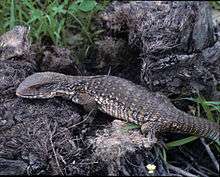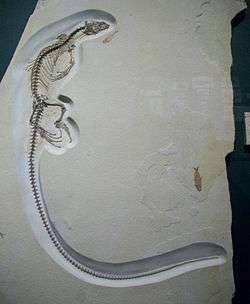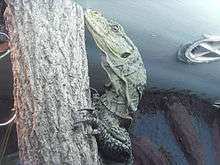Varanidae
| Varanids Temporal range: Late Cretaceous - Holocene, 80–0 Ma | |
|---|---|
 | |
| Komodo dragon (Varanus komodoensis) | |
 | |
| Savannah monitor (Varanus exanthematicus) | |
| Scientific classification | |
| Kingdom: | Animalia |
| Phylum: | Chordata |
| Class: | Reptilia |
| Order: | Squamata |
| Superfamily: | Varanoidea |
| Family: | Varanidae Merrem, 1820 |
| Genera | |
Varanidae is a family of lizards of the superfamily Varanoidea. The family, a group of carnivorous and frugivorous lizards,[1] includes the extinct Megalania (the largest known lizard), the Komodo dragon (the largest living lizard), and the crocodile monitor. The Varanidae contain the living genus Varanus and a number of extinct taxa. Their closest living relatives are the anguid and helodermatid lizards.[2]
Taxonomy
Varanidae was defined by Estes, de Queiroz and Gauthier (1988) as the clade containing the most recent common ancestor of Lanthanotus and Varanus and all of its descendants.[3] A similar definition was formulated by Conrad et al. (2008), who defined Varanidae as the clade containing Varanus varius, Lanthanotus borneensis, and all descendants of their last common ancestor.[4] Using one of these definitions leads to the inclusion of the earless monitor lizard (Lanthanotus borneensis) in the family Varanidae.
Lee (1997) created a different definition of Varanidae, defining it as the clade containing Varanus and all taxa more closely related to Varanus than to Lanthanotus;[5][6] this definition explicitly excludes the earless monitor lizard from Varanidae. Whether Lanthanotus borneensis is included in or excluded from Varanidae depends on the author: for example, Vidal et al. (2012) classify the earless monitor lizard as a member of a separate family Lanthanotidae,[7] while Gauthier et al. (2012) classify it as a member of Varanidae.[8]
Genera

- Genera marked with † are extinct
Genera usually included in Varanidae (under subfamily Varaninae according to Conrad et al., 2008)):
- †Iberovaranus Hoffstetter, 1969 - Considered to be a junior synonym of Varanus by Delfino et al. (2013).[9]
- †Ovoo Norell, Gao, & Conrad, 2008[10]
- †Saniwa Leidy, 1870
- Varanus Shaw, 1790
Genera sometimes included in Varanidae (under subfamily Lanthanotinae according to Conrad et al., 2008). Treated as under the separate family Lanthanotidae by other authors:
- †Aiolosaurus Gao and Norell, 2000[10]
- †Cherminotus Borsuk-Bialynicka, 1984
- Lanthanotus Steindachner, 1878
Basal varanoids:
- †Saniwides Borsuk-Bialynicka, 1984
- †Telmasaurus Gilmore, 1943[10]
- †Palaeosaniwa Gilmore, 1928 - Might actually be more closely related to helodermatids than to varanids.[4]
Formerly included in Varanidae:
- †Pachyvaranus Arambourg, 1952 - Moved to a separate group of varanoid squamates, Pachyvaranidae, by Houssaye et al. (2011).[11]
Phylogeny
Below is a cladogram from Conrad et al. (2008) that shows relationships within Varanoidea:[12]
| Varanoidea |
| ||||||||||||||||||||||||||||||||||||||||||||||||||||||||||||
| |
Biology

Monitor lizards are reputed to be among the most intelligent lizards. Most species forage widely and have large home ranges,[13] and many have high stamina.[14] Although most species are carnivorous, three arboreal species in the Philippines (Varanus olivaceus, Varanus mabitang, and Varanus bitatawa) are primarily frugivores.[1][15] Among species of living varanids, the limbs show positive allometry, being larger in larger-bodied species, although the feet become smaller as compared with the lengths of the other limb segments.[16]
Varanids possess unidirectional pulmonary airflow, including airsacs akin to those of birds.[17]
See also
References
- 1 2 Welton, L. J.; Siler, C. D.; Bennett, D.; Diesmos, A.; Duya, M. R.; Dugay, R.; Rico, E. L. B.; Van Weerd, M.; Brown, R. M. (2010). "A spectacular new Philippine monitor lizard reveals a hidden biogeographic boundary and a novel flagship species for conservation". Biology Letters. 6 (5): 654–658. doi:10.1098/rsbl.2010.0119. ISSN 1744-9561. PMC 2936141
 . PMID 20375042.
. PMID 20375042. - ↑ Fry, B.G.; Vidal, N; Norman J.A.; Vonk F.J.; Scheib, H.; Ramjan S.F.R; Kuruppu S.; Fung, K.; Hedges, B.; Richardson M.K.; Hodgson, W.C.; Ignjatovic, V.; Summerhays, R.; Kochva, E. (February 2006). "Early evolution of the venom system in lizards and snakes" (PDF). Nature. 439 (7076): 584–588. doi:10.1038/nature04328. PMID 16292255.
- ↑ Estes, Richard; Kevin de Queiroz; Jacques Gauthier (1988). "Phylogenetic Relationships within Squamata". In Richard J. Estes. Phylogenetic Relationships of the Lizard Families: Essays Commemorating Charles L. Camp. Stanford University Press. p. 166. ISBN 9780804714358.
- 1 2 Conrad J. (2008). "Phylogeny and systematics of Squamata (Reptilia) based on morphology". Bulletin of the American Museum of Natural History. 310: 1–182. doi:10.1206/310.1.
- ↑ Lee MSY (1997-01-29). "The phylogeny of varanoid lizards and the affinities of snakes". Philos Trans R Soc Lond B Biol Sci. 352 (1349): 53–91. doi:10.1098/rstb.1997.0005. PMC 1691912
 .
. - ↑ Michael S.Y Lee (2005). "Molecular evidence and marine snake origins". Biology Letters. 1 (2): 227–230. doi:10.1098/rsbl.2004.0282. PMC 1626205
 . PMID 17148173.
. PMID 17148173. - ↑ Nicolas Vidal, Julie Marin, Julia Sassi, Fabia U. Battistuzzi, Steve Donnellan, Alison J. Fitch, Bryan G. Fry, Freek J. Vonk, Ricardo C. Rodriguez de la Vega, Arnaud Couloux and S. Blair Hedges (2012). "Molecular evidence for an Asian origin of monitor lizards followed by Tertiary dispersals to Africa and Australasia". Biology Letters. 8 (5): 853–855. doi:10.1098/rsbl.2012.0460. PMC 3441001
 . PMID 22809723.
. PMID 22809723. - ↑ Jacques A. Gauthier, Maureen Kearney, Jessica Anderson Maisano, Olivier Rieppel, Adam D.B. Behlke; Kearney; Maisano; Rieppel; Behlke (2012). "Assembling the Squamate Tree of Life: Perspectives from the Phenotype and the Fossil Record". Bulletin of the Peabody Museum of Natural History. 53 (1): 3–308. doi:10.3374/014.053.0101.
- ↑ Massimo Delfino, Jean-Claude Rage, Arnau Bolet and David M. Alba (2013). "Synonymization of the Miocene varanid lizard Iberovaranus Hoffstetter, 1969 with Varanus Merrem, 1820". Acta Palaeontologica Polonica. in press. doi:10.4202/app.2012.0025.
- 1 2 3 Conrad, JL; Balcarcel, AM; Mehling, CM (2012). "Earliest Example of a Giant Monitor Lizard (Varanus, Varanidae, Squamata)". PLoS ONE. 7 (8): e41767. doi:10.1371/journal.pone.0041767.
- ↑ Alexandra Houssaye, Nathalie Bardet, Jean–Claude Rage, Xabier Pereda Suberbiola, Baâdi Bouya, Mbarek Amaghzaz and Mohamed Amalik (2011). "A review of Pachyvaranus crassispondylus Arambourg, 1952, a pachyostotic marine squamate from the latest Cretaceous phosphates of Morocco and Syria". Geological Magazine. 148 (2): 237–249. doi:10.1017/S0016756810000580.
- ↑ Conrad, J.; Rieppel, O.; Grande, L. (2008). "Re-assessment of varanid evolution based on new data from Saniwa ensidens Leidy, 1870 (Squamata, Reptilia)" (PDF). American Museum Novitates. 3630: 1–15. doi:10.1206/596.1.
- ↑ Perry, G.; Garland, T., Jr. (2002). "Lizard home ranges revisited: effects of sex, body size, diet, habitat, and phylogeny" (PDF). Ecology. 83 (7): 1870–1885. doi:10.1890/0012-9658(2002)083[1870:LHRREO]2.0.CO;2.
- ↑ Clemente, C.J.; Withers, P.C.; Thompson, G.G. (2009). "Metabolic rate and endurance capacity in Australian varanid lizards (Squamata; Varanidae; Varanus)". Biological Journal of the Linnean Society (]). 97 (3): 664–676. doi:10.1111/j.1095-8312.2009.01207.x.
- ↑ Greene, Harry W. (1986). Diet and Arboreality in the Emerald Monitor, Varanus prasinus, with Comments on the Study of Adaptation. Chicago: Field Museum of Natural History. OCLC 14915452. Retrieved 12 December 2013.
- ↑ Christian, A.; Garland, T., Jr. (1996). "Scaling of limb proportions in monitor lizards (Squamata: Varanidae)" (]). Journal of Herpetology. 30 (2): 219–230. doi:10.2307/1565513. JSTOR 1565513.
- ↑ Unidirectional Airflow In The Lungs Of Birds, Crocs And Now Monitor Lizards